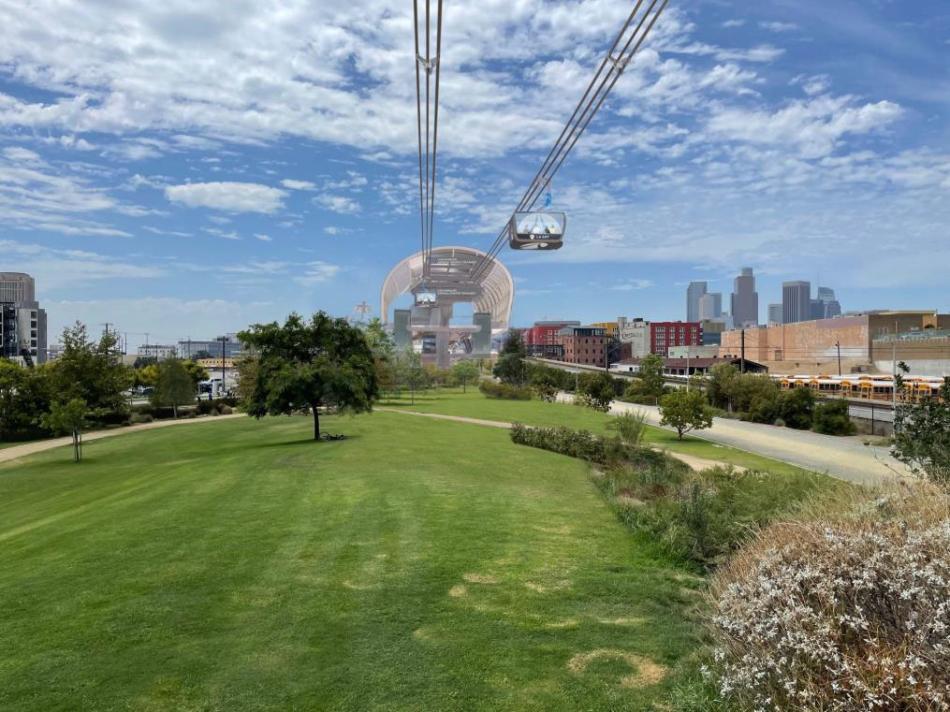After a marathon hearing, Metro's Board of Directors has voted to approve the construction of an aerial gondola system connecting the Dodger Stadium parking lots with Los Angeles Union Station continue - but with a laundry list of conditions.
The $500-million project, announced more than five years ago by Los Angeles Aerial Rapid Transit (LA ART), has financial backing from former Dodgers owner Frank McCourt, although operations of the system would be turned over to Climate Resolve affiliate Zero Emissions Transit after completion. Plans call for a roughly 1.2-mile route, running north from Union Station on cables suspended more than 100 feet above Alameda Street until reaching a stop next to Metro's Chinatown Station and Los Angeles State Historic Park. From there, the alignment would veer west above Bishops Road toward Dodger Stadium.
According to an environmental study conducted for the project, maximum capacity on the gondola system is estimated to be 5,000 passengers per hour. Cabins would travel at a speed of approximately 13.4 miles per hour with headways of 23 seconds, leading to an end-to-end trip of seven minutes. The study forecasted that construction could commence as early as 2024 and conclude within 25 months.
The gondola has faced fierce opposition from residents in the Chinatown community, who have launched a website seeking to block its construction, as well a legal battle waged by the California Endowment, which is headquartered near the route. The project managed to overcome the court challenge last year.
Although it recommended approval of the gondola, a Metro staff report also acknowledged troubled history behind the two landmarks the project aims to connect. Union Station was built on land that was home to L.A.'s original Chinatown, kicking off an era in which the neighborhood would find itself suffering the brunt of regional transportation impacts such as the construction of the 101 and 110 freeways. Likewise, Chavez Ravine home to thousands of residents who were displaced in the 1940s to make way for a never-realized public housing project, only to see that land used instead to lure the Dodgers west from Brooklyn.
That history, combined with continued gentrification and displacement in modern Chinatown, was reflected in many comments to the board expressing opposition to the project - including from 1st District Los Angeles City Councilmember Eunisses Hernandez. Many opponents argued that the the project would spur gentrification in Chinatown, while not providing true transportation benefits or traffic relief. Others objected to potential visual impacts to Los Angeles State Historic Park, which would sit below the route.
However, a number of community members also spoke in support of the project, lauding the offer of free rides and the gondola's potential to help struggling restaurants in Chinatown. The Los Angeles Times recently covered how Zero Emissions Transit and the California Endowment has jockeyed behind the scenes to rally residents of the William Mead Homes public housing complex to their side, providing money for community events and local activists, respectively.
The history of Dodger Stadium and Chinatown also informed some of the conditions that the Board has attempted to place on the project. The gondola's environmental study points to planned public benefits including pedestrian amenities between Chinatown Station and L.A. State Historic Park, as well as public art, support for a new bridge connecting North Broadway to the park, and new landscaped open space in other locations. Among other conditions, the Board motion would require that Zero Emission Transit:
- create a business interruption fund to compensate local businesses and organizations impacted by construction;
- permanently set aside 10 percent of marketing opportunities for local Chinatown businesses and organizations;
- offer free and unlimited riders to Chinatown residents and businesses in perpetuity;
- install bike and micro-mobility hubs and each project station;
- develop a community benefits agreement which would include anti-displacement funds for residents and businesses; and
- provide funding for the Dodger Stadium Express.
Additionally, the motion adopted by the board instructs staff to report back within six months on what other measures could be used to improve game day access to Dodger Stadium, potentially including a bus rapid transit line on Sunset Boulevard or other complete streets upgrades.
Likewise, the motion assumes the eventual development of the Dodger Stadium parking lots. McCourt, a developer, has been active in the surrounding neighborhood, planning more than 500 apartments on properties along Stadium Way during 2023, although none of those projects involve the stadium parking lots. While the City of Los Angeles will ultimately have the authority to regulate any future development of the parking lot, the Metro Board has nonetheless imposed a condition on the gondola project requiring that 25 percent of the developable space surrounding the stadium be set aside for affordable or supportive housing.
Follow us on social media:
Twitter / Facebook / LinkedIn / Threads / Instagram
- Dodger Stadium Gondola (Urbanize LA)






